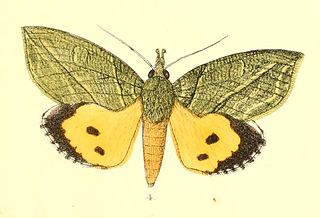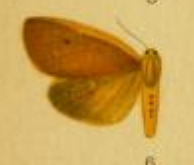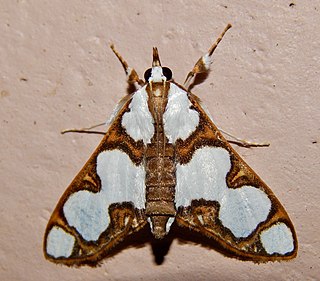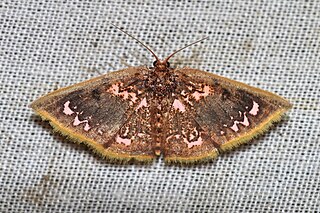
Colotis danae, the crimson tip or scarlet tip, is a small butterfly of the family Pieridae, that is, the yellows and whites. It is found in Asia and Africa.

Curetis bulis, the bright sunbeam, is a species of butterfly belonging to the lycaenid family. It is found in Asia.

Vindula erota, the common cruiser, is a species of nymphalid butterfly found in forested areas of tropical South Asia and Southeast Asia.

Corcobara is a monotypic moth genus of the family Erebidae first described by Frederic Moore in 1882. Its only species, Corcobara angulipennis, described by the same author in the same year, is found in India, Thailand, Cambodia, Myanmar, Malaysia, Indonesia, New Guinea, Sri Lanka and the Solomons.

Eudocima homaena is a moth of the family Erebidae first described by Jacob Hübner in 1816. It is found in the Indian subregion, Sri Lanka, Taiwan, the Nicobars, Peninsular Malaysia, Borneo, the Philippines and on Christmas Island. It is a major pest on orange plants.

Eudocima hypermnestra is a moth of the family Erebidae described by Pieter Cramer in 1780. It is found in China, Thailand, Taiwan, India and Sri Lanka.

Ctenoplusia limbirena, the Scar Bank gem, or silver U-tail, is a moth of the family Noctuidae. It is found in south-western Europe, Africa, the Canary Islands, Arabia, the southern Himalayas, India, Sri Lanka, Indochina to south-eastern China, Taiwan, Sulawesi, Bali and Timor. In New Zealand, it has been established since 2011.
Hyblaea constellata is a moth in the family Hyblaeidae first described by Achille Guenée in 1852. It is found in India, Sri Lanka, south-east Asia, including China, Japan, Taiwan, Myanmar and Thailand. It is also found in Queensland, Australia.
Callidrepana patrana is a moth in the family Drepanidae. It was described by Frederic Moore in 1866. It is found in Nepal, India, Cambodia, Sri Lanka, Thailand, mainland China, Japan and Taiwan.

Spilosoma gynephaea is a moth in the family Erebidae. It was described by George Hampson in 1901. It is found in South Africa and Zimbabwe.

Spilosoma latiradiata is a moth in the family Erebidae. It was described by George Hampson in 1901. It is found in South Africa and Zambia.

Spilosoma nigrocastanea is a moth in the family Erebidae. It was described by Walter Rothschild in 1917. It is found in Malawi.

Cirrhochrista pulchellalis is a moth in the family Crambidae. It was described by Julius Lederer in 1863. It is found on Ambon Island, Java and Sri Lanka.
Syllepte tetrathyralis is a moth in the family Crambidae. It was described by George Hampson in 1912. It is found in New Guinea.
Drapetodes fratercula is a moth in the family Drepanidae. It was described by Frederic Moore in 1887. It is found in Sri Lanka, north-eastern Himalaya, Borneo, Bali, and Sulawesi.

Chrysocraspeda abhadraca is a species of moth in the family Geometridae described by Francis Walker in 1861. It is found in Indian subregion including India and Sri Lanka, Peninsular Malaysia, Sumatra and Borneo.
Doratopteryx steniptera is a moth in the Himantopteridae family. It was described by George Hampson in 1919. It is found in Tanzania.
Semioptila dolicholoba is a moth in the Himantopteridae family. It was described by George Hampson in 1920. It is found in Malawi.
Semioptila latifulva is a moth in the Himantopteridae family. It was described by George Hampson in 1920. It is found in Tanzania.

Semioptila flavidiscata is a moth in the Himantopteridae family. It was described by George Hampson in 1910. It is found in South Africa, Zambia and Zimbabwe.












